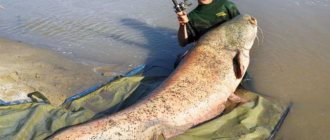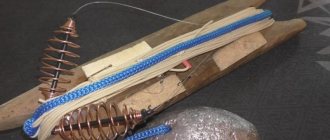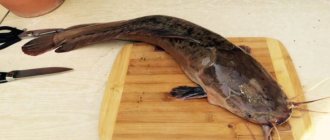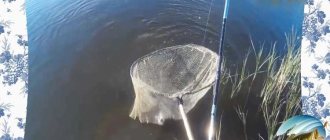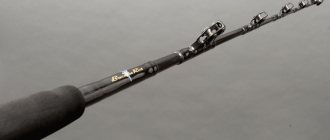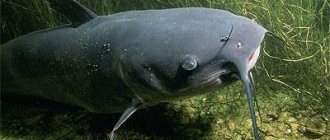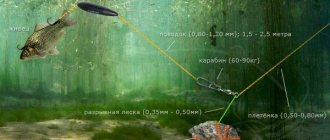Donka for catfish is the very first tackle with which an angler tried to catch this giant of our freshwater reservoirs. The effectiveness of the gear has not lost its relevance in our time, having included modern materials and progressive equipment that help control the bite and confidently fight the caught fish. Experienced somyatniks collect donka for catfish with their own hands, taking into account the specifics of the reservoir chosen for fishing and the habits of the fish population living there. Hunting for catfish is a serious undertaking that requires careful consideration of every detail, including selecting a place to install fishing equipment, assembling the gear itself, and determining the optimal type of bait, which is currently of particular interest to the fish in its diet.
Equally important attention is paid to knowledge of trophy fishing techniques, which are distinguished by a scrupulous approach to the safety of getting to the shore and subsequent storage of the caught fish. Indeed, in most cases, it happens that spotting and catching a catfish is much easier than coping with the subsequent landing of a powerful barbel without losing the tackle and without getting injured from cuts from the cord of your hands. We will cover all the nuances of fishing presented above in the article offered to the reader, trying to make catfish fishing both successful and safe in all its respects.
When to catch catfish on a donk
Catching catfish on a donk from the shore has its own clear time frame, which is limited to two summer months, including July and August, and covering the first half of September. This is due to the specific life rhythms of heat-loving fish and the possibilities of the structure and installation of the donkey itself for catching catfish. In view of the fact that structurally bottom tackle is used to fish on flat areas of a reservoir, and as is known, the mustachioed giant prefers underwater holes and ditches under steep banks, it is worth clearly knowing the time when fish enter flat-bottomed and relatively shallow water areas, which happens during the above-mentioned periods of summer and autumn.
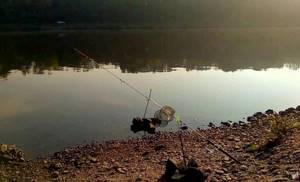
At this time, catfish feed at twilight and at night on flat shallows with very warm water, emerging from holes and snags from the main river channels and fast currents. Fishing for catfish from the shore is planned for a couple of days throughout the day. Fish are more active in the dark, but large catfish are possible during the pre-storm period and during the day, while small catfish can successfully bite, regardless of the intensity of illumination.
Important! Cloudy weather is preferable to bright and hot sunny days. A sprinkling of fine warm rain and a light wind that makes ripples on the water always stimulate biting activity. Sharp cold snaps, as well as drops in atmospheric pressure, make the bite passive and unstable.
Preparing gear
To catch your trophy, you need to carefully consider the choice of gear for catching catfish on the river. Before fishing you need to prepare and check:
- A powerful rod 2.5–3 meters long.
- Convenient, durable, inertia-free carp reel.
- Dense monofilament line with a diameter of up to 11 mm for small fish and nylon thread or braided double fishing line for catching large prey. The length of the fishing line must be at least 150 meters.
- A leash no more than 0.5 meters long and with a diameter 1.15 mm thinner than the main line.
- A load weighing from 50 to 120 grams. The choice of weight depends on the expected catch and the current on the river.
- The hook (double or tee) can be from No. 10 to No. 40.
After checking the gear, you can assemble the bottom equipment for catching a trophy with your own hands.
Donka for catching catfish
You can catch a predator using bottom tackle with a float, which is designed to lift live bait from the bottom. This gear is assembled as follows:
- a sinker weighing 150 grams is attached to the end of the fishing line;
- after 15 cm from the sinker, first one double hook is tied, and after a short distance - a second one;
- after another 10 cm, one of the ends of a powerful carabiner is attached to the fishing line, which must be tied well to the main fishing line.
To create a leash for a catfish you will need:
- thread a thread or double fishing line through a load weighing 150–170 grams;
- place a small sliding bead under the load;
- tie the end of the fishing line to the carabiner with a fishing knot;
- attach a high-quality forged hook to the fishing line, the size of which depends on the weight of the intended catch;
- After 15–20 cm from the hook to the fishing line, a carabiner is attached using a loop.
The leash blanks are ready, now you can go to the pond and look for a place where predators are staying.
Places suitable for catching catfish
Bottom tackle for catfish is installed on the flat bottom of a reservoir, therefore, the habitat of the mustachioed fish must be looked for taking into account these terrain features. As a rule, promising fishing spots are quiet river backwaters, approaching holes in the river bed and areas of snags. Smooth exits of the bottom from deep areas to coastal shallows should also be included in the range of fishing areas under consideration. On lakes, the habitats of giants look like vast backwaters cutting deep into the coastline, opening onto the shore as sandy beaches, the edges of which are fenced on the sides with a wall of reeds or sedges. On reservoirs, promising places will be dams and concrete-reinforced banks that go straight into the water. A depth of two meters is sufficient for feeding both small individuals and especially large specimens.

Important! For installation of gear, hard banks with convenient entries into the water are selected for optimal opportunities for landing already caught fish.
Two types of bottom gear for catching catfish
The gear for catching catfish on a donk can be made in two versions. The first type of gear includes the construction of donks using the classical method, when the cord is equipped with leashes and a weight and tied on the shore to a pole rigidly installed in the ground. Varieties of the classic method of bottom fishing are the elastic donka and the multi-hook net.
The second option is the installation of bottom equipment using a rod and reel cord as a basis, which in its modern form looks like installing equipment on a spinning rod or feeder gear. The use of both types of gear does not differ much in terms of fishing conditions; the main distinguishing feature is the multi-hook nature of the classic gear and only a single hook of the catch. It is also worth noting the greater coverage of the fishing area by the classics of the bottom genre and the precise installation of the bait supply on the hook. But installing the equipment on the rod allows you to use a feeder with bait and fish in a bottom hole, which is impossible to do with a classic donka. We will consider the design features of equipment types in more detail in the further description of the topic.
Donka with a rod
Bottom tackle for catching catfish using a rod consists of a powerful, heavy fiberglass plug base, which includes a massive inertia-free reel. To install gear on the shore of a reservoir, all kinds of stands are used. They are used starting from an ordinary wooden flyer stuck deep into the ground and ending with a rod-pod for a couple of similar rods. The installation itself is simple and consists of a hundred-meter piece of braided cord, a blind sinker, a powerful hook and a float to hold and control the installation of bait on catfish above the bottom of the reservoir. After casting the equipment, the cord is equipped with a bite alarm, which can be either a bell or an electronic buzzer.
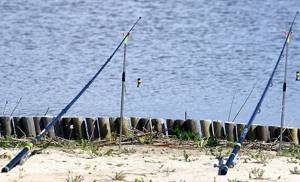
Important! To ensure the safety of the rod from being pulled into the water by a fish that has taken the bait, it is recommended to equip the butt of the tackle with a safety carabiner, which is hooked with a cable or rope to fixed elements installed on the shore of the reservoir, which can be trees, cars and dam structures.
Zakidushka without a rod
In the classic version, donkey equipment for catfish is stored on a wooden reel, which during fishing is used as an element for attaching gear on the shore. About hundreds of meters of the main braided cord are wound onto the reel, which is supplied with leashes made of monofilament fishing line, equipping them with small floats for lifting the bait from the bottom and directly with the hook itself. The distance between the leads is at least five meters, which allows you to fish the bottom most effectively. The cord can be attached to the load either directly or through an elastic band, popularly called a model, which allows, when stretched, to serve leashes with hooks without removing the load from the water. Having secured the reel with a cord rigidly fixed to it to a support on the shore, a shock-absorbing loop is arranged. To do this, use a meter-long piece of rope, tied between a one and a half meter bend of the main fishing line. After casting, the line of the tackle is pulled all the way and equipped with an alarm.
Important! It is advisable to use combined alarms, sound and light, since catfish fishing mostly occurs in the dark, and installing a firefly allows you to more accurately and accurately determine the triggered gear.
Fishing methods
Perhaps every novice angler has heard about each of the methods below. An exception may be the last kwok method, which we will discuss below. The remaining methods are not distinguished by their originality.
Spinning
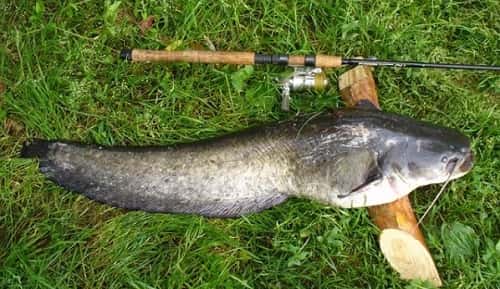
What is important here is an exceptional knowledge of the bottom of the reservoir. The difficulty arises when fishing is done from the shore. In this case, the fisherman is limited in his capabilities. Both the fishing area and the inability to “read” the bottom using an echo sounder are limited.
When fishing for catfish using a spinning rod, it is advisable to use a boat with an echo sounder to find the best places where the fish are most likely to be found. Large deep-sea wobblers are used as bait. Due to their size, they make enough noise and vibration to attract any predator.
Gear you will need:
- A rod 3-3.2 m long for fishing from the shore and 1.5-2.1 m for a boat
- The reel is inertia-free with a spool size of 2000-4000, it is worth noting: the further the casts, the larger the reel
- Braided cord with a diameter of 0.40-45 mm or fishing line with a thickness of 0.60 mm
- Steel leash 20 cm long
- The bait can be a large wobbler from 110-170 mm with a depth of 4-6 m (Rapala Super Shad Rap, Rapala Countown Magnum, Bomber Deep Down Long A and others)
After throwing the wobbler, expect it to sink to the bottom. Next, start slow wiring. It is important to note that catfish do not like to get tired of the chase, so use a sluggish retrieve. If you get a bite, don’t force things, slowly pump the fish out from the bottom, tiring it out. Only after you feel that the catfish is giving up can you speed up the process a little.
Na kwok
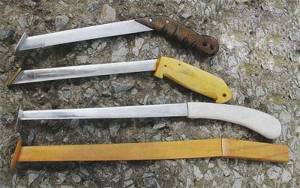
The method is available only to those who have a boat, which is where fishing is carried out. Kwok is a plastic, metal or wooden device of a curved shape, with a “heel” at the end.
When approaching a promising place, the bait is lowered into the water; it is important to immerse it at half the depth. For this, short side fishing rods (2-3 pieces) with a nod are most often used.
If the boat has a holder for fishing rods, this is a huge plus; you don’t have to worry that the catfish will steal the tackle and you won’t have time to react. Next begins the methodical tapping of the quok on the water.
Afterwards, you should carefully monitor the tips of the fishing rods, as the bite can be sharp and confident. It can happen both during a pause, between knocks, and during them.
Required gear:
- Fishing rod 1-1.5 m fast action. Or a reel with cord or fishing line
- Fishing line with a diameter of 0.60 mm or braided cord 0.45 mm
- Hook size 6/0 - 11/0, this is a universal option
- Animal bait: beef or chicken liver, frogs, bunch of worms, chicken offal, barley shell
Donkoy
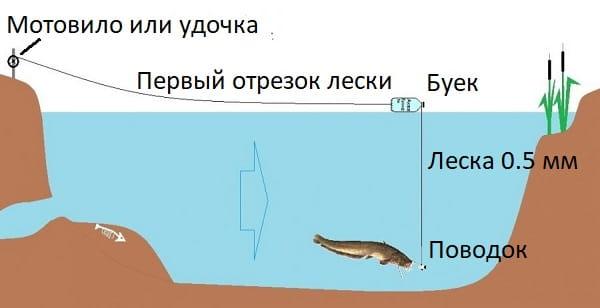
The first option is classic and there are no difficulties in it. A fishing line with a weight, a leash and a hook is tied to the reel. It is equipped with bait and thrown into the water. Read below about how to assemble such tackle with your own hands. The second option has a secret: the bait should not lie on the bottom. If you use the method we suggest, your chances of catching will increase.
What is necessary:
- Plastic bottle (1-1.5 l)
- Two pieces of fishing line
- Leash
- Hook
- Reel (fishing rod)
The main piece of fishing line is tied to the reel, which leads to the bottle (acts as a buoy) and is tied to it. A second piece of fishing line or braided cord is tied to the neck; its length depends on the depth of the fishing spot (not reaching 10-20 cm to the bottom). Next, a metal leash with a hook and bait is mounted. That's it, the structure is launched into the catfish hole (or any other promising place).
Trolling
The method is demanding for the fisherman. In addition to a boat with a motor, you need a large river or reservoir where you can walk with gear thrown into the water, which imposes its own limitations. If you have all this, then the gear you will need is:
- Rod 1.90-2.1 m long, fast action, 100-120 g cast
- Inertia-free reel with 4000-6000 spool, preferably with a friction brake
- Braided cord with a diameter of 0.45-0.60 mm
- Steel leash 20-30 cm long
- As a bait, a deep-sea wobbler (specific models are described above, in the chapter on spinning fishing)
The conditions are approximately the same: the catfish is not a fan of showing agility when hunting. Therefore, the speed of the boat is selected depending on the bait and the current: it is enough for the wobbler to start playing, nothing more. There is also no need to go to the middle of the river, where the current will be quite strong. It is much more promising to find holes, snags, and fallen trees away from the riverbed: there it is easier for the catfish to fight the current, so it is worth looking for it here.
How to make donka for catfish
The construction of bottom gear requires a certain approach to the reliability of the material used in the collection. Since the catch can be significant in size and weight, and even provide strong resistance when fishing, you must initially plan on using accessories with an increased durability life. The thinness and miniature size of the equipment will allow you to attract and force the catfish to take the bait, but it will be almost impossible to remove it from the water. Somyatniks, adequately understanding these contradictions, consciously and deliberately go for the device of rougher installations, thereby reducing the likelihood of a bite, but increasing the success of capture. Let's look at how to properly make a donk for catfish using the example of the options for selecting elements of tackle recommended below, focusing on describing the characteristics and parameters of each of them in more detail.
Fishing rod for catfish
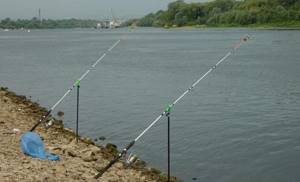
As reliable rods, we advise you to choose feeder versions of heavy carp plug gear no longer than three meters with high tests and medium types of action, which will allow you to quickly hook a fish that has taken the bait and at the same time, without fear of breakage fishing rods, exhaust the fish with a long struggle, using the ability to absorb shocks with a soft form of tackle. Reinforced rings, as well as the massive butt of the fishing rod, should not confuse the fisherman, because the intended catch will not tolerate the thinness of the tackle and will crush it at any opportunity.
Reel for catfish
Like the rod itself, the catfish reel is borrowed from carp fishing. The tackle is equipped with a massive spinning rod with a capacious spool and the ability to clip the cord. The volume of the spool should easily be able to accommodate hundred-meter sections of braided cord with a diameter of at least 0.3 mm. A prerequisite is the presence of a baitrunner reel and, of course, a friction brake in the device, which will protect the gear from loss and help more efficiently deal with caught fish.
Important! The gear ratio is not so important in this type of fishing and can be as small as desired, the main thing is that the traction force allows you to hold large masses without exposing the mechanism of the product to critical loads.
Fishing line for catfish
Rigid braided cords are more efficient in catfish fishing, allowing for finer control of fishing and providing a reliable feeling when fighting strong fish. Damping the efforts of a caught trophy is largely entrusted to the rod and reel, but preserving the catch directly depends on the parameters of the fishing line. Braided cords are used, starting from 0.3 mm. The color of the braid does not play a significant role, but shades of green tones are more acceptable, less noticeable in warm, algae-colored standing summer waters. At least one hundred meters of fishing line are wound onto the spools, avoiding knots and abrasions in its structure, which will significantly reduce the breaking loads of the accessory.
Hooks for catfish
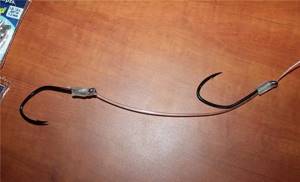
Features of catching large catfish are the ability to use large and elastic hooks that reliably resist bending. On donks, hooks with a long shank made of thick wire and a sealed ring of a fastening element are used.
Important! The hook for catfish should have the tip bent inside its radius to reduce the likelihood of the bait bait spontaneously coming off.
The sharpened edge of the accessory allows you to avoid idle bites when the fish tries the bait, squeezed by the predator’s mouth in the area of the brush made of small and hard teeth.
Sinker for catfish
Lead forms in the form of cones and pyramids with the possibility of being firmly attached to the fishing line of the tackle are used as weights for hooks. The weights are selected based on the weight of the bait and casting distance. The method of mounting the load using the blind method does not in any way affect the number of bites, because even small catfish can easily lift hundred-gram lead ingots when biting without regard for caution, but it adds reliability to the gear, eliminating unnecessary friction of sliding loading options on the surface of the cord. When catching catfish from a boat on a donk, especially for elastic, it is possible to use a load in the form of a brick or other object that exceeds the weight of even a couple of kilograms.
How to be guaranteed to catch a catfish
Catfish is perhaps the largest and most famous freshwater predator of the Lower Volga. Catfish reach truly gigantic sizes.
Thus, in the last century, on the Lower Volga, near Astrakhan, a catfish weighing more than 500 kg was caught, as evidenced by historical chronicles.
These days, such giants are very rare, but even today, no, no, and even today a photo with a 3-meter monster caught somewhere on the Volga or on Akhtuba will flash in fishing periodicals.
Catfish, as a deep-sea predator, choose places on the river for permanent habitat where there are deep holes with a slow or circular current.
This fish is heat-loving and is most active in warm water. In winter, the catfish falls into torpor, accumulating at the bottom of deep holes.
Catfish is a bottom predator. This truism is known to every fisherman.
The conclusion suggests itself: you can catch it with a donk and quite successfully. The equipment for fishing from the bottom is extremely simple.
A heavy sliding sinker weighing 100-150 g, depending on the strength of the current in the chosen fishing spot. The downward movement of the sinker is limited by a powerful power swivel, to which a thick, durable leash made of braided fishing line is attached, or, even better, a thin braided metal cable.
The hook is thick, sharp and super strong. Its size is selected depending on the size of the nozzle and the expected production. The main line is also braided and very strong.
In any case, after I had four line breaks with a diameter of 0.4 mm during one morning of fishing in the Lower Volga, the passion for light tackle disappeared! To use such equipment, you will need an appropriate rod: a marine type, designed to fight powerful big fish. It is best to equip it with a powerful, reliable multiplier.
Only such tackle will give you all the trump cards in the fight against mighty fish and the opportunity to catch catfish. Unfortunately, most fishermen, when going on a catfish hunt, are not fully aware of what kind of opponent they will be dealing with.
Hence the broken rods, the cut teeth of gears in reels, and bloody fingers with the help of the famous “Nevskaya”, pieces of fishing line, broken fasteners and hefty tirades of profanity addressed to unruly fish.
Catching large catfish should be approached with all responsibility. Each element of the gear must be checked and rechecked. With all of the above, you should not get carried away with outright rudeness. Despite all its omnivorous nature, catfish rarely take bait on rough, clumsy tackle.
When fishing for catfish, the bait most often used is a frog, attached to a hook by the hind leg. Live bait works well, of which asp, ide, small beetle and sabrefish are unrivaled.
You can also use cutting - fillet from the side of fresh fish. In the fall, bird (crow) offal, smoked over a fire, is successfully used (they stay on the hook to death, attracting catfish from a long distance). In the spring, a bunch of crawlers or tough meadow worms work great.
In the midst of the summer heat, fishermen of the Lower Volga are sure to successfully catch catfish using a piece of laundry soap (the cheapest). Apparently, the smell of the fats from which it is cooked attracts catfish without fail.
The best time to catch catfish on a donk is dawn, early morning and evening. It often happens that in the morning the fish does not take it, and in the evening, as if it has broken free from the chain, it does not allow the frog to sit calmly on the hook. Large seasoned catfish often attack the bait already in the dark, this is especially typical for the summer hunts of the “mustache” for sabrefish.
So, the largest catfish that one of my friends told me about was caught in the Gerasimovka River (a tributary of the Lower Volga). He bit at 11:30 p.m., and was pulled out of the water at 4:30 a.m. The fish pulled 216 kg! When fishing from a boat, an indispensable rule is maintaining silence. Catfish is a very cautious predator.
It is also unacceptable for the boat to yaw at anchors, leading to twitching and dragging of baits. Often, the hungriest and largest catfish first barely noticeably tries the bait and only if nothing suspicious is found does it finally take it.
The “tasting” period can last up to half an hour, so there is no need to rush into hooking the catfish. Even after a powerful wide pull, you should wait a couple of seconds, clench your teeth, and only then hook. Catfish rarely drop the bait, and if the bite turns into a stretch, half the battle is already done.
After hooking, the most important phase of the fight begins—fishing. First, you need to try to determine the size of the catfish that grabbed the bait. This is not a simple matter. Still, fear has big eyes, and sometimes a 20-kilogram catfish seems gigantic. On the other hand, often very large catfish in the first
For a minute he behaves quite quietly and even walks towards the boat. But at the last moment the picture may change beyond recognition. Skill comes with experience. And yet, having estimated who you have to deal with, try to assess the situation and plan further actions.
Having torn the fish from the bottom, to which it strives with all its might (this is a favorite technique of catfish), it is necessary not to allow it to go into snags, if there are any nearby.
It is also dangerous when a mustachioed predator heads towards the shore, but traveling towards the channel, towards the current, is welcome - the fish will get tired faster, and the fisherman has more room to maneuver. Often a large catfish lies on the bottom and it is not possible to tear it off even with critical loads on the tackle.
In such a situation, it’s worth making some noise, tapping the boat with something hard, tapping the bent rod of the rod several times. The catfish does not tolerate noise and, most likely, will stir and move away. Fighting large catfish requires great endurance and physical strength. A special catfish belt can make survival easier; the rod handle is inserted into the quill.
When fishing, the load is distributed on the angler's lower back and hips. Gradually tiring the catfish, it is not worth forcing fishing to the maximum load of the gear - it’s a shame to lose a worthy trophy in the bustle. Finally, a piece of fishing line covered with mucus appears from the water, and an abundant group of small bubbles rises - a clear sign that the catfish will soon appear on the surface. Last efforts, and the “mustachioed” appears in all its glory.
The main thing is not to get confused out of habit. Sometimes a catfish suddenly appearing at the side of the boat seems too menacing. Maintaining calm and composure and bringing the catfish closer, you can take the fish in two ways: either with a hook, gently picking it up by the notch under the lower jaw, or with a hand dressed in a special mitten, grasping directly the lower jaw.
The fear of putting your hand into a catfish’s mouth usually goes away after the second or third trophy, but caution never hurts. In any case, it is easier to fight large catfish with two people.
Victory! Fish in the boat! Perhaps this is your record?! And yet, think about whether it’s worth destroying the catfish? After all, if he has reached, say, fifty kilograms in weight, he may be older than you! And if you are not interested in a pile of meat, a couple of good photographs are enough for enthusiastic memories, and in a few years the released catfish may again give you unforgettable moments of gambling!
Author: A.A. Chernushenko “Trophy fishing on the lower Volga and Akhtuba”
- What and how to feed the place where you catch catfish
- Locust bait for catfish
Catfish bait
Catching catfish on a bottom from a boat or from the shore is most likely using live bait in the form of fish that live in the fishing area. Since gear is mostly used to hunt in standing or slightly flowing backwaters, inert baits are less in demand by predators due to their low mobility, which is less effective at luring fish to the fishing spot, especially if it is not very active. The only exception is a bunch of large crawlers strung on a hook, which attract catfish with their specific smell, despite their low mobility compared to fish-shaped bait. Of the most attractive and tenacious fish on a hook, loaches, spined lances and minnows are suitable for catfish fishing. Crucian carp and roach are considered second in importance and interest to catfish. Small catfish weighing a couple of kilograms are successfully caught using a bunch of leech and a live frog strung on a hook by puncturing the skin on the amphibian’s back. Catching catfish in the fall with a donk is also possible with small birds singed along with their feathers. Typically, chicken or waterfowl such as duck or teal are used for this.
How to catch catfish on a donk
Having chosen a promising fishing spot, the fisherman begins to install the gear, starting its installation no later than a couple of hours before the onset of evening, because the time of evening twilight and the first half of the night are the most catchy in relation to other parts of the day. Next, we will consider the technology and technique of fishing when using various types of gear, specifying the important aspects of the execution of the main elements of fishing.
Read more about bottom fishing and preparing different types of bottom rigs.
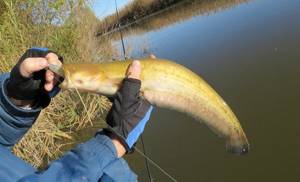
Small catfish must be released
With a rod
Having installed a stand for the rod on the shore and equipped the hook with a nozzle, cast the tackle, paying attention to the accuracy of the bait, in view of its possible dislocation with an excessively strong swing and subsequent impact on the water.
Important! The equipment that has reached the bottom is pulled up with a reel until the cord is fully tensioned, which can be seen from the tense quiver tip of the rod.
After tensioning, the cord is equipped with an alarm and a bite is expected. Catfish bite sharply, picking up the bait and continuing their movement without pause. Such a pull should be immediately accompanied by a hook and, sensing the resistance of a fish that has landed on the hook, you must promptly begin to land it. Fishing is carried out with a reel, gradually winding the cord and tiring the fish by pulling the form in the direction opposite to the trajectory of the fish. The mustachioed predator is quite strong and resilient, and the fight with a large individual can continue for dozens of minutes, and sometimes hours, with varying success.
Tired fish are identified by the release of bubbles to the surface, which is the moment for more decisive action to reel in the line. The best technique is to drag the trophy onto a flat bank. Small catfish are immediately placed on the kukan. The large fish are caught in the head area with a humanizer and after this manipulation the hook is released and the specimen is croaked, placing it on a rope near the shore.
Without a rod
It is more convenient to cast a classic donkey by placing a load from the boat. In this case, the live bait remains guaranteed to be intact, and the tackle itself is controlled for installation in order to avoid tangling of the leads. Biting, like hooking a fish, is similar to the previous fishing method, but fishing has significant differences. Catfish from the shore are taken on a classic donka with strict control of laying the extended cord in a certain place, in a way different from rings and loops. The hunter must wear overalls on his hands to prevent cuts from the fishing line . Sudden withdrawals of fish are accompanied by the fisherman lowering a small amount of line and then holding the fish, which must be repeated until the resistance of the predator subsides. They take catfish into the landing net close to the shore. You can use a net only after catching an individual no more than five to seven kilograms. A large predator is pulled ashore by grabbing it in the shallows with their hands under the gills or taking it by the lip.
Live bait for catching catfish on a bottom rig
If you plan to catch catfish with live bait, then first of all pay attention to its size.
Statistics show that the catfish you catch with live bait will be about 8-9 times larger than it. Thus, if the bait weighs about 500 grams, then the caught trophy will weigh approximately 4-5 kg. Therefore, the greater the mass of the bait, the greater the mass of the caught catfish.
In addition, many experienced fishermen recommend fishing with fish that you caught in the same body of water. Catfish have a very well developed sense of smell and will prefer local prey. Therefore, catfish bite very poorly on purchased live fish.
Catching catfish on a donk from a boat and precautions
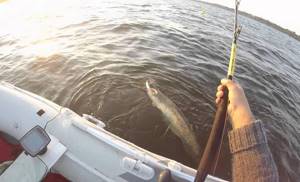
Catfish are caught from a boat using hooks with a reel and rods with the already described type of bottom mounting. To attach fish to the fishing site, you can use a quok, which will be an additional incentive for the predator to search for bait. It is worth paying special attention to safety measures when fishing from boats, carrying out the fishing process with a partner who can help in landing the caught giant. The key points are to avoid winding the cord around your hand when landing fish and to randomly throw the cord into the boat when winding it up while the fish is sitting on the hook.
Failure to comply with these recommendations directly threatens the safety of the fisherman’s life. After all, a cord wound around the hand or a noose tightening the leg when biting a fish over 50 kg can easily pull the angler over the side of the boat and cause serious trouble for him. It is also not recommended to lift particularly large trophies into the boat, in order to avoid its flooding if it capsizes. It is better to tow the fish to a flat bank and place it on a kukan there.
Safety precautions when catching catfish from a boat
Catching catfish from the shore is very simple, since it does not pose any particular danger to the fisherman himself. However, fishing from a boat can lead to unexpected consequences. Therefore, it is necessary to familiarize yourself with the safety measures in advance:
- To protect yourself as much as possible in the event of a strong jerk of a catfish, prepare a knife or high-quality scissors in advance so that in case of danger to your life you can cut the fishing line.
This must be done because there is a possibility that the supply of fishing line that is under the fisherman’s feet, when the catfish jerks, can wrap it around his leg and drag the person into the water;
- You should not wrap the fishing line around your hand, as when catching a large catfish you can say goodbye to your limb forever;
- If you realize that you have caught a very large catfish, then you should not immediately lift it onto the boat. When airborne, it becomes very active and can easily capsize a boat. Therefore, keep the catfish in the water and as soon as you go ashore, start fishing for it.
